The Carvel Story: How a flat tire on Memorial Day weekend 1934 inflated an ice cream empire
The story goes that Tom Carvel's ice cream truck broke down in Hartsdale 89 years ago this weekend -- and the rest is sweet history. Here's the Retrologist's tour and guide to vintage stores.

On Memorial Day weekend in 1934, Thomas Carvelas was 28 years old but had already racked up a lifetime of living. At the age of 4, he emigrated from Greece to Manhattan’s Lower East Side, his big family (three brothers and three sisters) among the legions trying to find their way in America. The young Carvelas had already tried out a few careers, among them Dixieland band drummer and auto mechanic in New York City. He had a head for machinery, too, which would come in handy later for reasons I will soon explain.
His life took a fateful turn when a doctor in 1932 delivered troubling news: Carvelas had tuberculosis — a dark spot on his lung seemed to prove it — and he’d be wise to get out of the city. He didn’t go far physically, but in every other regard, an epic journey was about to begin.
Westchester County, just to the north of the city, beckoned, promising a restorative elixir of fresh air and nature. (No strip malls and office parks yet!) The doctor, it turned out, got it wrong — Carvelas did not have TB, but no matter, he’d find his life’s calling in Westchester: iconic ice cream man with an Anglicized last name, Carvel.
There were no Carvel stores in the early days — just a truck he’d bought with a $15 loan from his wife, which he would joke he never repaid. That truck broke down on Memorial Day weekend 89 years ago, a flat tire marooning him across from a pottery store at 95 South Central Ave. in Hartsdale, New York, according to the company origin story. Carvel said he was on his way to a county fair when the breakdown happened, but he made a sale before he could figure out what to do. Customers didn’t mind the melty ice cream, and they kept coming. He stayed put for the weekend, hooking up his truck to a power outlet at the pottery shop, he said in 1976, and cleared $100, a pretty good haul in the middle of the Great Depression.
Soft ice cream, huh? OK, soft ice cream it is. Fate had served him a big idea.
Carvel, the lore goes, turned what could have been a ruinous experience into a recipe for building a business that would lead to hundreds of stores, fame as a gravel-voiced, malaprop-prone avuncular pitchman, and wealth so vast he owned three homes along with his own golf course.
Carvel, with that mechanical mind of his that kept the U.S. Patent Office busy, worked up a machine for soft serve, and in 1936, he opened the first Carvel store on the very spot of that pottery store in Hartsdale, where he got his big break because of his truck’s breakdown. Among his inventions was a special freezer for the perfect preservation of dairy that he would say became the industry standard.
Seeing the success Carvel was having, other entrepreneurial-minded folks wanted to get their hands on his soft-serve machine, but they didn’t quite know how to use his contraption, leading Carvel to start franchising the concept that would officially be known as Carvel Dari-Freeze.
By the 1950s, Carvel had built a booming business, one that he tightly controlled, to the point where franchisees chafed and repeatedly sued on antitrust grounds, the government even stepping on the franchisees’ behalf. (Outside influence on the chain was reportedly likened to “The Devil” in an internal training videotape.)
For Carvel, his system, demanding and exacting though it may have been, was all about quality control and protecting the trademark, once saying that “poison one child, and 50 years of business goes down the drain.” Some franchisees didn’t see it that way, upset about his demanding ways and requirements to buy all products, from syrups to napkins, from Carvel-approved vendors.
Carvel would prevail in the courts, even if the legal woes perpetually antagonized him, and hurt growth for years. (In 1985, he did relent in a court settlement, allowing franchisees to use other vendors for certain purchases.)
He once bemoaned losing his most profitable store, in Pennsylvania, amid a massive drop in franchisees in the 1960s that Carvel told David Letterman in 1982 amounted to 73% of the chain, before recovering ground in the 1970s and 1980s.
Carvel was coping with legal hassles while other chains expanded by leaps and bounds. An article from the 1970s wondered if Carvel could have boomed like Burger King and McDonald’s had the legal woes never come along. In fact, in the 1960s, Carvel even dabbled in the burger business, with the short-lived Hubie Hamburgers chain.
Curiously, Carvel often claimed to have turned down a chance to get in on the ground floor at McDonald’s, further claiming that he helped Ray “The Founder” Kroc with franchise-contract language and building-design advice. (Carvel was a charming impish man prone to many boasts, with every single one posing a challenge for fact-checkers.)
Well, the public was likely unaware of all the legal drama, or didn’t much care. They just liked the ice cream, and they liked the guy pitching it to them. Indeed, they probably liked both so much because Carvel was so good at maintaining those high standards, working tirelessly almost to the end of his life.
Much like Kroc and his Hamburger University, Tom Carvel had the Carvel Inn in Yonkers, New York, a motel that he converted into a complex from which he ran his empire, trained franchisees, and recorded his commercials.
Ah yes, let’s talk about those commercials.
Carvel’s early radio ads were traditional, read live by a golden-throated announcer who Carvel said botched a commercial about a store opening in Manhattan. Reasoning that if the professionals at CBS could get away with screwing up, he decided he could do the same, and it would cost a lot less. After all, he knew the product best, so from then on out, he insisted on delivering the ads himself, crimes against the English language and all.
He eschewed scripts and advertising agencies. He’d sit in on recording sessions with new franchisees opening Carvels, giving them talking points but otherwise insisting that they be themselves, because being himself had worked all too well for Mr. Carvel, which is what everyone called him.
Carvel shared one anecdote that sums up his approach to marketing. The ice cream king was at a retirement dinner, and a top advertising executive pulled him aside to tell him, ever so politely, just how awful his ads were, mentioning the time and channel on which he’d seen a particular one. Carvel asked the guy whether he remembered the commercials that ran before and after the “very bad” Carvel spot. The advertising executive could not.
Carvel had proved his point. He liked to be right, and he usually was.
I was born in 1973 and raised in the heart of Carvel country, and Tom Carvel is a very early memory, showing up during practically every commercial break on the local NYC TV channels, exhorting me to buy Fudgie the Whale, Cookie Puss, Hug Me The Bear, and other cakes, reminding me that “Wednesday is Sundae” at Carvel, and, at the end of each ad, thanking me for my support.
I published this gem from the WABC-TV archives featuring Tom Carvel — you must give it a watch. It will help you understand the man perhaps more than this entire article!
The voice is oft-imitated, never duplicated, compared by earlier generations to the character actor Andy Devine. With the bulbous nose and roly-poly mein, Carvel had a touch of Jimmy Durante, too. The ice cream man’s pipes were not smoothed by the quart of soft serve — often of his favorite flavor, chocolate — that Carvel once consumed daily, according to a vivid article in Suburban Today in 1981.
Local pitchmen (and women) added flavor to the television and radio airwaves of 20th century, and the in-your-face marketing authenticity clicked with viewers. Who better to sell a product than the person behind it? Southern California had Cal Worthington touting gas-guzzling Detroit-built land boats; all of America had the loveably cantankerous Col. Harland Sanders selling buckets of fried chicken in prime time; and much of the East Coast had Tom Carvel, selling the likes of “Thinny Thin” ice cream for “fatty fats” like him.
But unlike Sanders, who sold the KFC chain and was simply a commercial pitchman in his final years, Carvel never loosened his grip on his company, the commercials a reminder that he was very much in the weeds.
Carvel, who bristled at the “r” word — retirement — finally did so in 1989, selling the company he and his wife, Agnes, owned for over $80 million. (We can assume she got back her $15 at this point.)
Tom Carvel did not get to enjoy that retirement for very long. The next year, on an October night after a day of golfing on the course he owned in Dutchess County, New York, Carvel died in his sleep. He was 84. He had a history of heart trouble, but that did not stop litigation years later alleging Carvel’s demise resulted from foul play.
Tom Carvel mixes it up with David Letterman in 1982, bringing a Fudgie the Whale cake to the whale of a host.
Carvel the brand is alive and well, and several legacy stores from Tom Carvel’s time survive, many in a form he would recognize. (My tour is below!) Alas, the original location in Hartsdale was demolished after closing in late 2008. They paved over paradise for a hibachi restaurant, but the significance of the land is not lost on those who know to look down. A plaque in the grass just outside honors Carvel’s legacy.
The plaque feels somewhat like a gravestone, and interestingly, Carvel’s final resting place is a mere 6-minute drive away, at Ferncliff Cemetery in Hartsdale.
It warms the heart to know he rests so close to where Carvel Dari-Freeze began.
TOUR OF CLASSIC CARVELS
All photos: Rolando Pujol
Note: Hang on to this list. It will be updated as I visit more locations!
CARVEL, Hackensack, New Jersey
MAP
This Carvel, located in a shopping plaza, is the last with twin cones on a pole. This one is a real heart-melter! Since 1969.
***
Carvel, West Hempstead, New York
MAP
In July 2018, this location still had its neon signage with the signature old-school Carvel typeface, sadly removed after a car crashed into the building and the store was closed for a spell. It still has its cones, thankfully!
***
Carvel, Massapequa, New York
MAP
This Carvel in Massapequa still has its twin neon signs and its cone!
***
Carvel, Glen Oaks, Queens
MAP
This Carvel retains its twin neon signs and has a period mansard roof to boot!
***
Carvel, Ridgewood, Queens
MAP
This Carvel saw its cones damaged during Hurricane Sandy in 2012. This is how it looked in 2014, and it has since been spruced up — and shorn entirely of its cones.
***
Carvel, Elmsford, New York
MAP
This location opened around 1958, and still features a vintage, hand-painted parking sign. Not far from Carvel’s original store, this one undoubtedly saw repeat visits from Mr. Carvel himself.
***
Carvel, Mamaroneck, New York
MAP
This Carvel still retains its classic form.
***
Carvel, Yonkers, New York
MAP
This location has been modernized and shares space with a Subway, but retains its cone. It’s down the road from the lost, original Carvel in Hartsdale.
***
Carvel, Ardsley, New York
MAP
Tom Carvel had a home in Ardsley, so presumably, this location was under the microscope of the exacting boss. It still retains its neon sign, in the back, and the freezer door in the back features the classic Carvel shield.
The photo shows the store when it was under renovation after a Subway that shared the building for a time was being removed. It’s now a standalone Carvel again.
***
Carvel, Port Chester, New York
MAP
This Carvel still features a hard-to-see cone on the roof, and a tall hand-painted sign that adds considerable charm. Note the shield logo on the trash can!
***
Carvel, Rye Playland
MAP
Even if you’ve never been to the charming amusement park Playland in Rye, New York, you’ve probably “visited” if you’ve ever watched the 1988 Tom Hanks classic “Big.” Yes, Zoltar is here, and if I had a wish for him, it would be for this location of Carvel never to change.
***
Carvel, the Bronx
MAP
A gorgeous survivor flanked with neon signage!
***
Carvel, West Haverstraw, New York
MAP
This location retains a vintage cone on its signage.
***
Carvel, New Milford, Connecticut
MAP
This one reminds me of the location in Queens I featured above.
***
Carvel, Westport, Connecticut
MAP
This location in a strip mall retains its neon sign.
***
Carvel, West Palm Beach Florida
MAP
This is Florida’s last standalone Carvel, in West Palm Beach, its cones rebuilt after the originals were destroyed by Hurricane Frances in 2004.
Carvel cones and hurricanes do not mix well.
***
Former Carvel, Hartsdale, New York
MAP
This is where it all began, where the truck broke down in 1934 and the first Carvel opened in 1936. It closed in 2008. This photo, featuring a friend of mine and taken on a low-resolution Treo 650 smartphone, dates to 2007.
The plaque on the grass just outside is all that’s left of Carvel on the land where it all began.





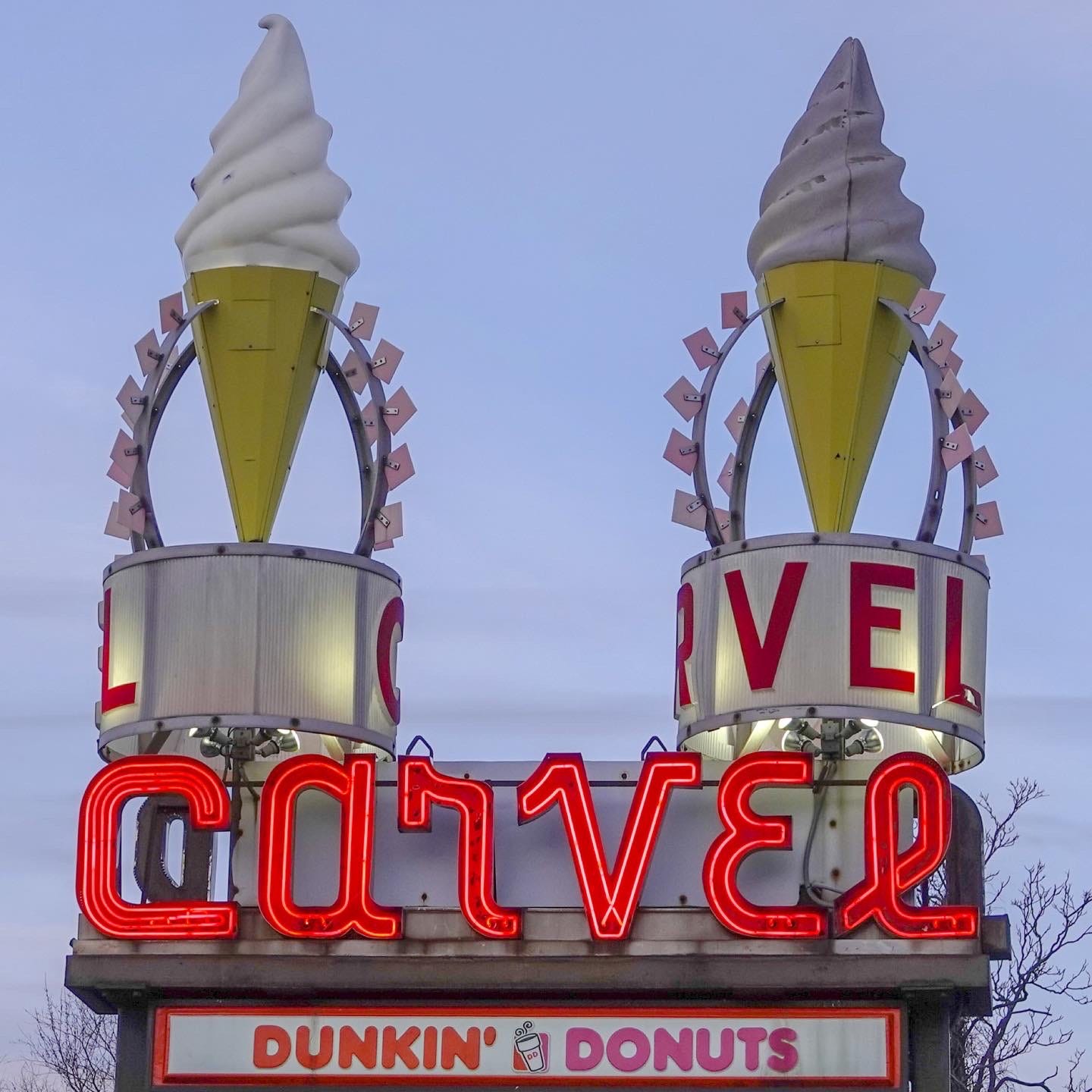


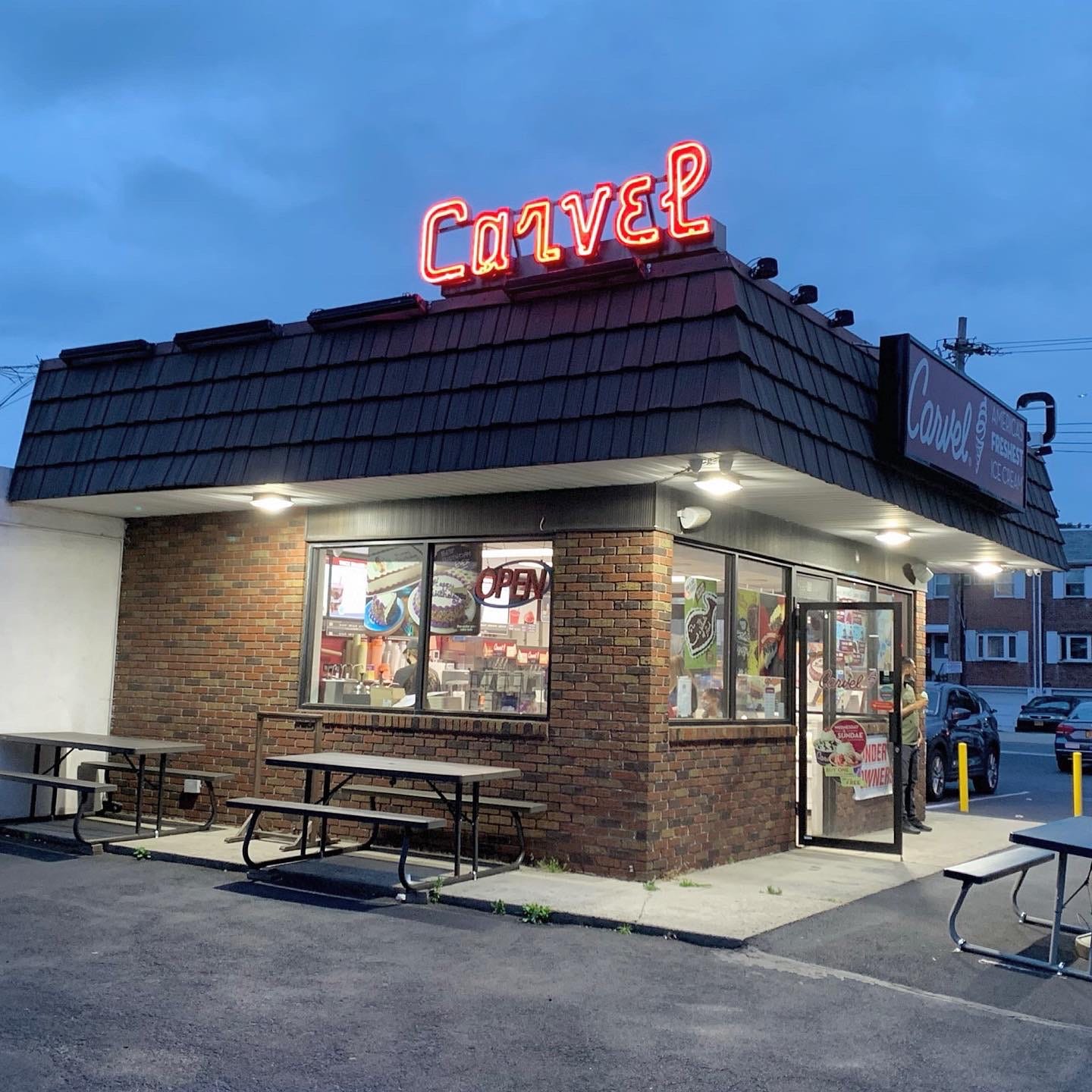

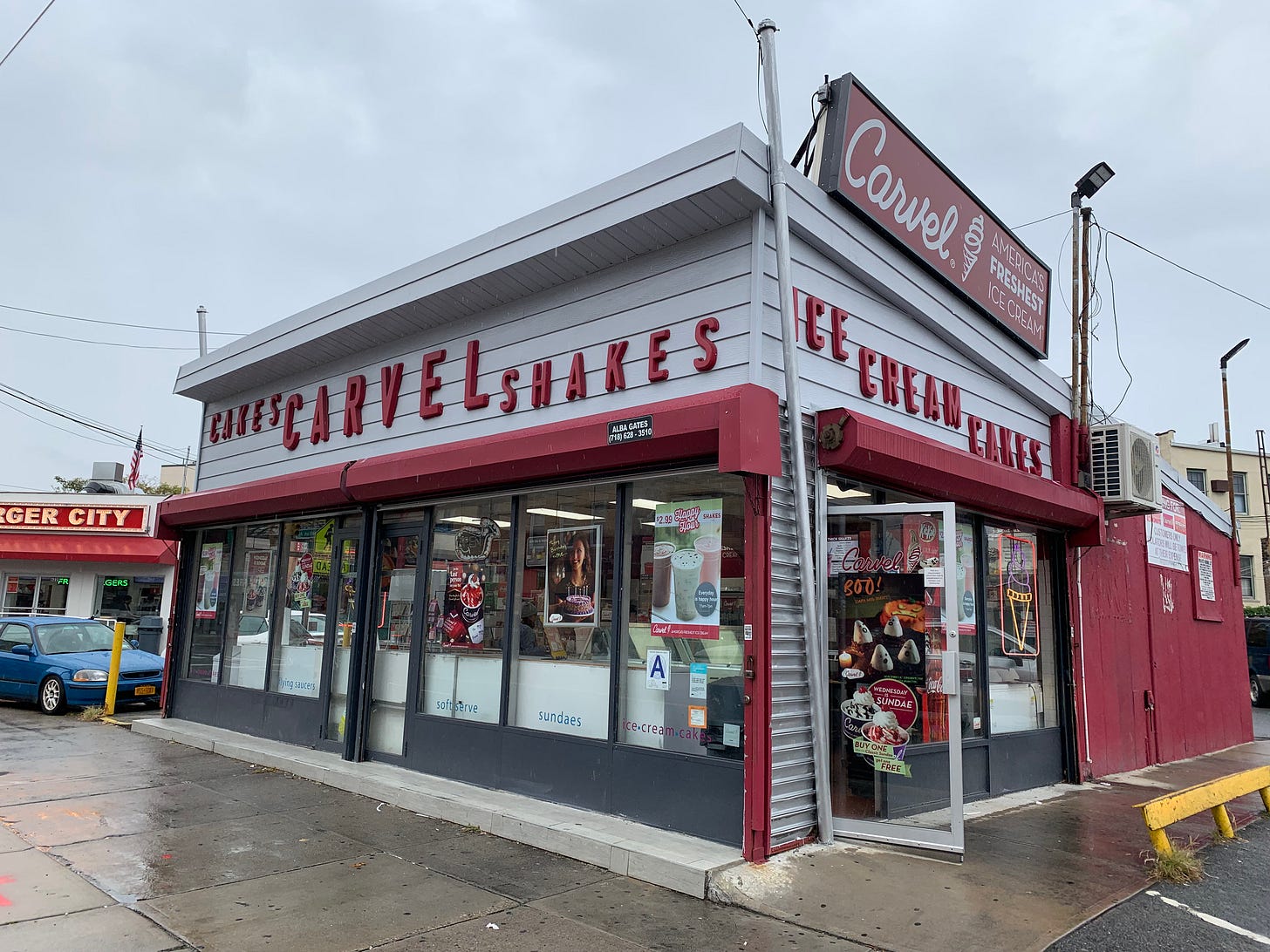


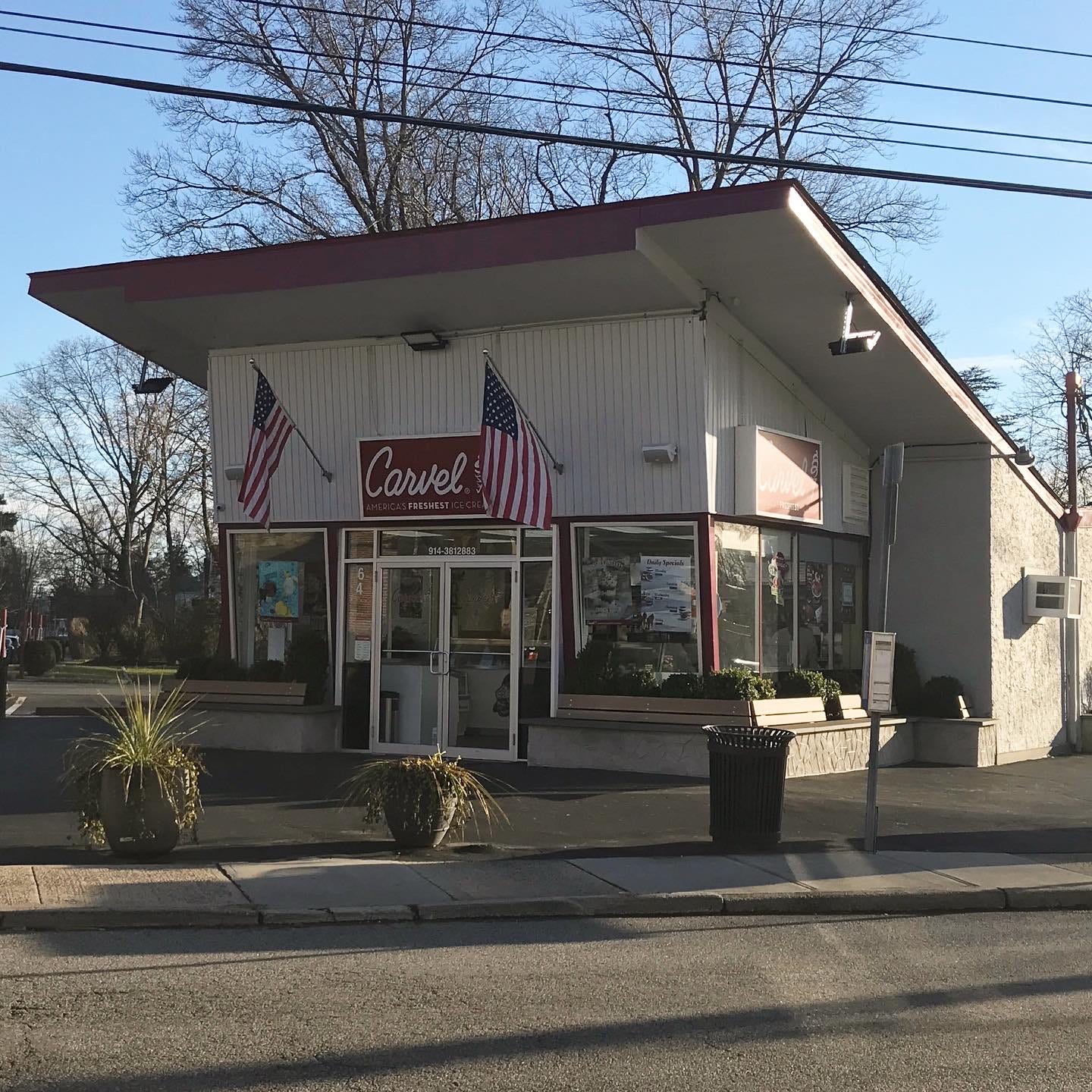



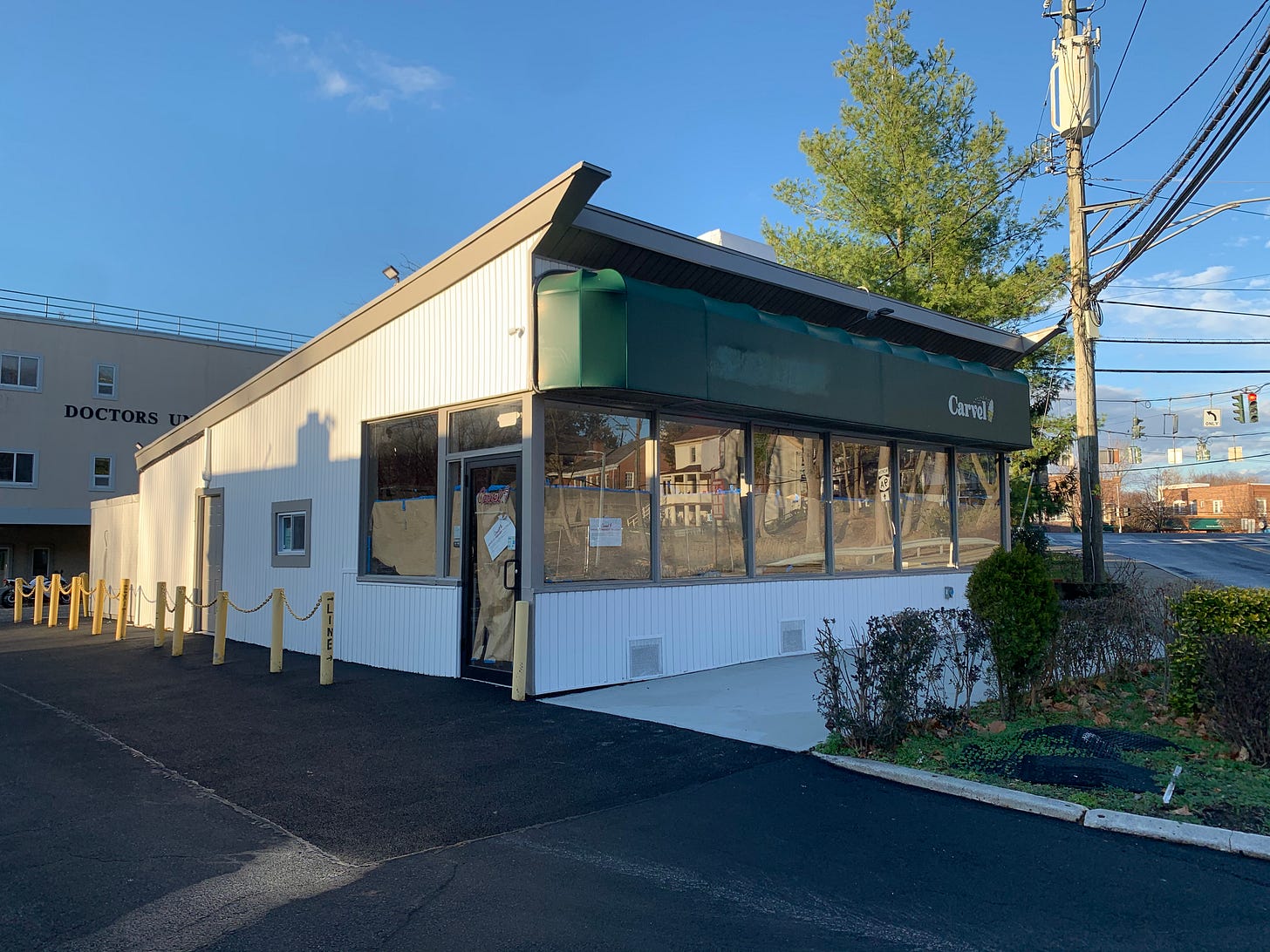

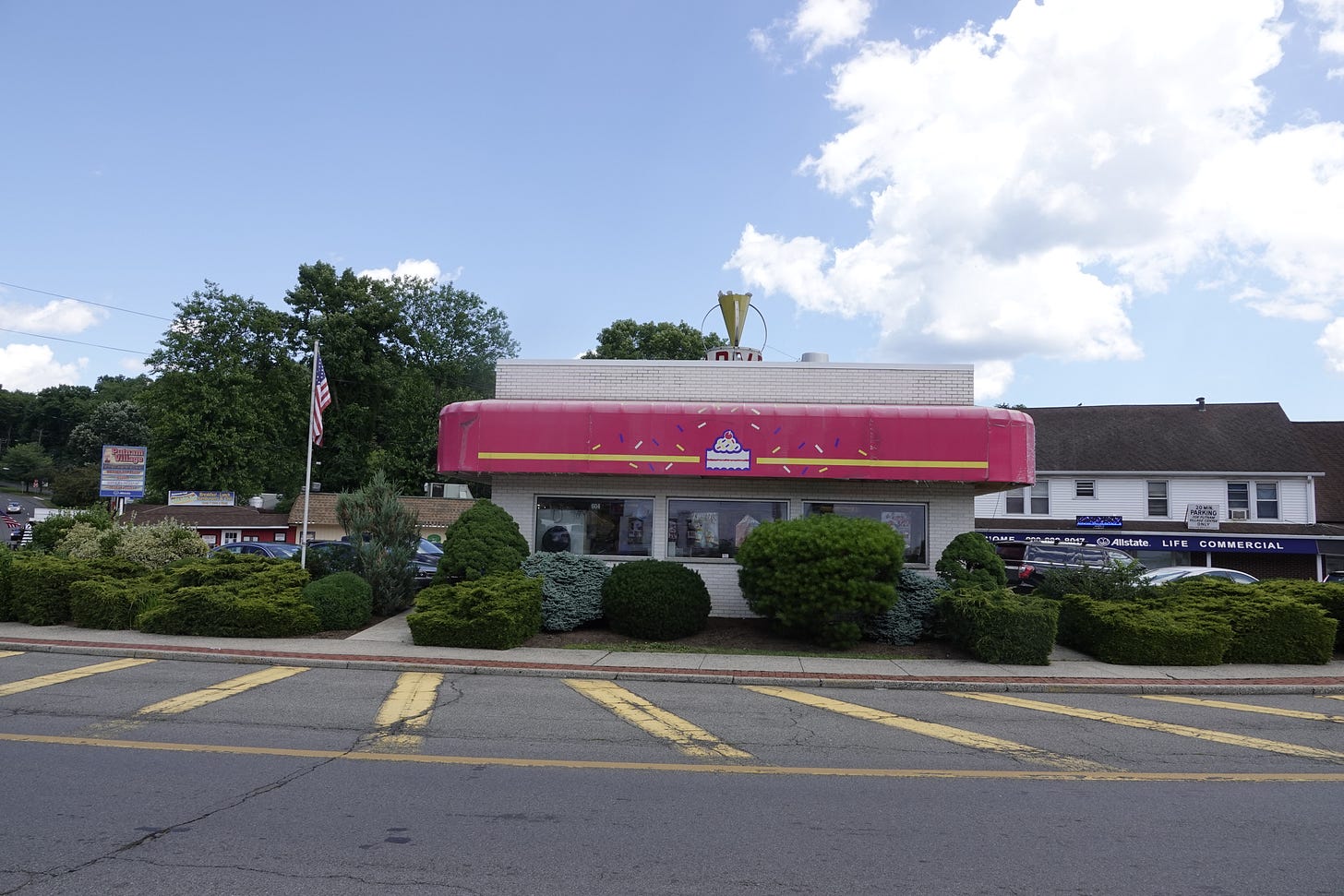



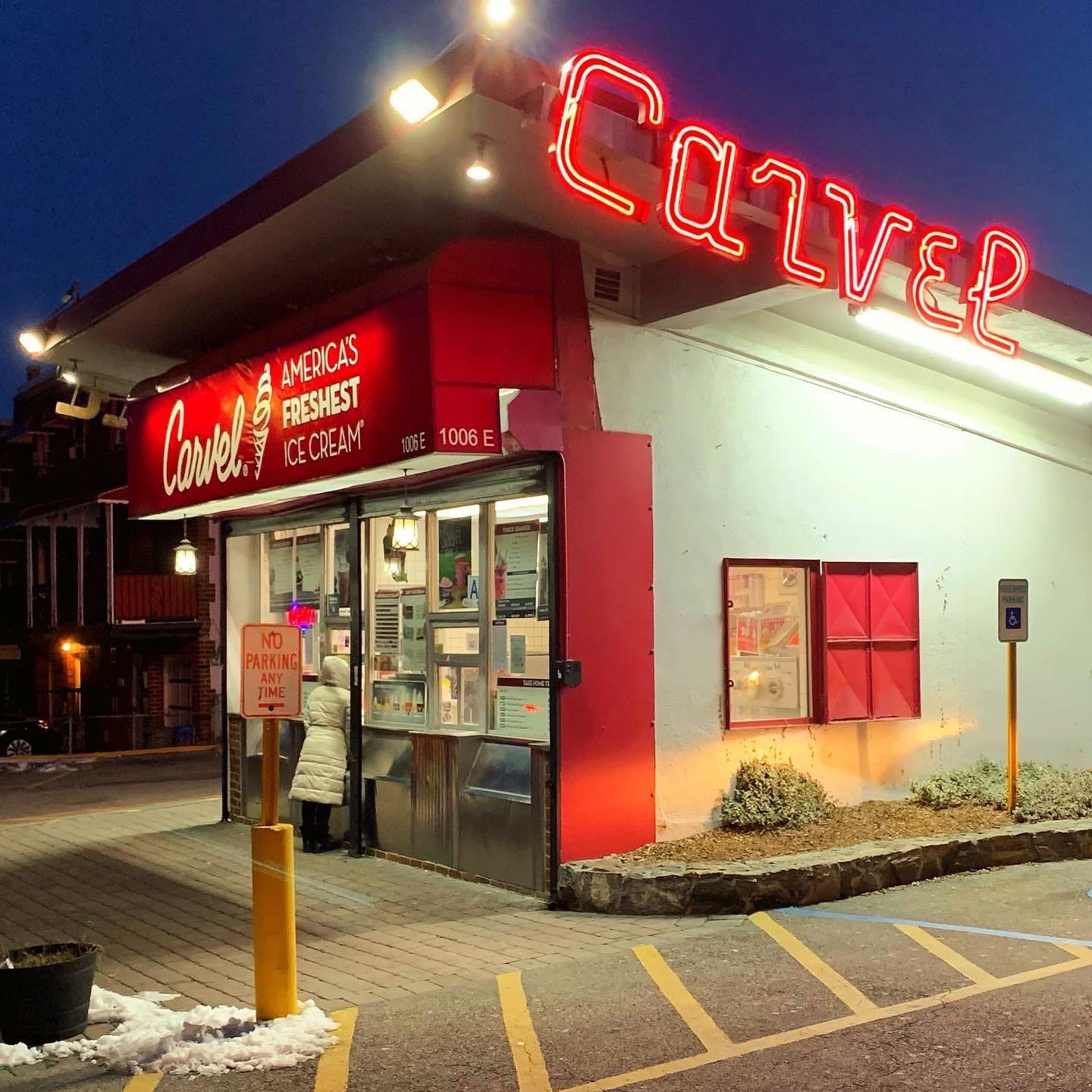
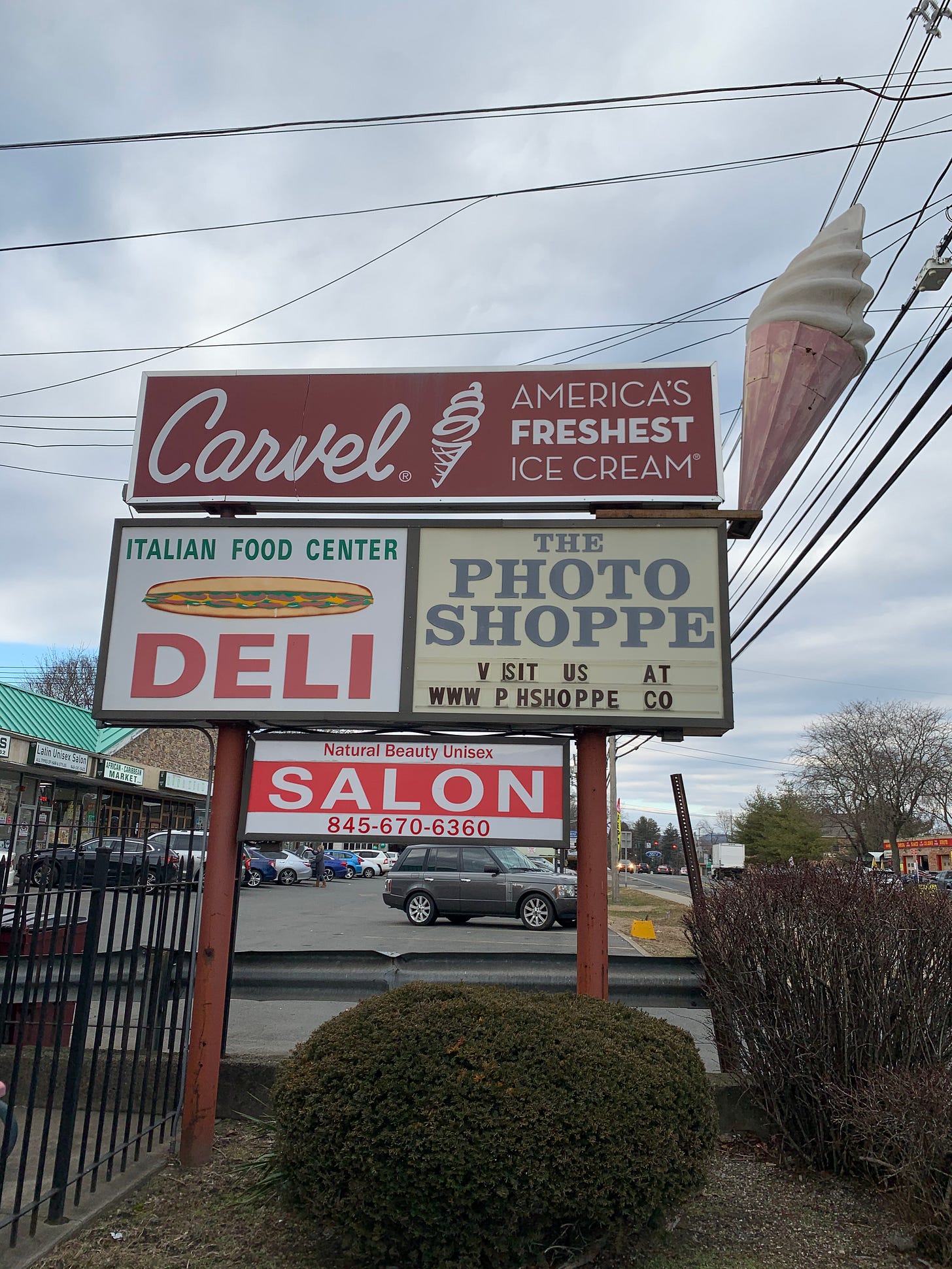
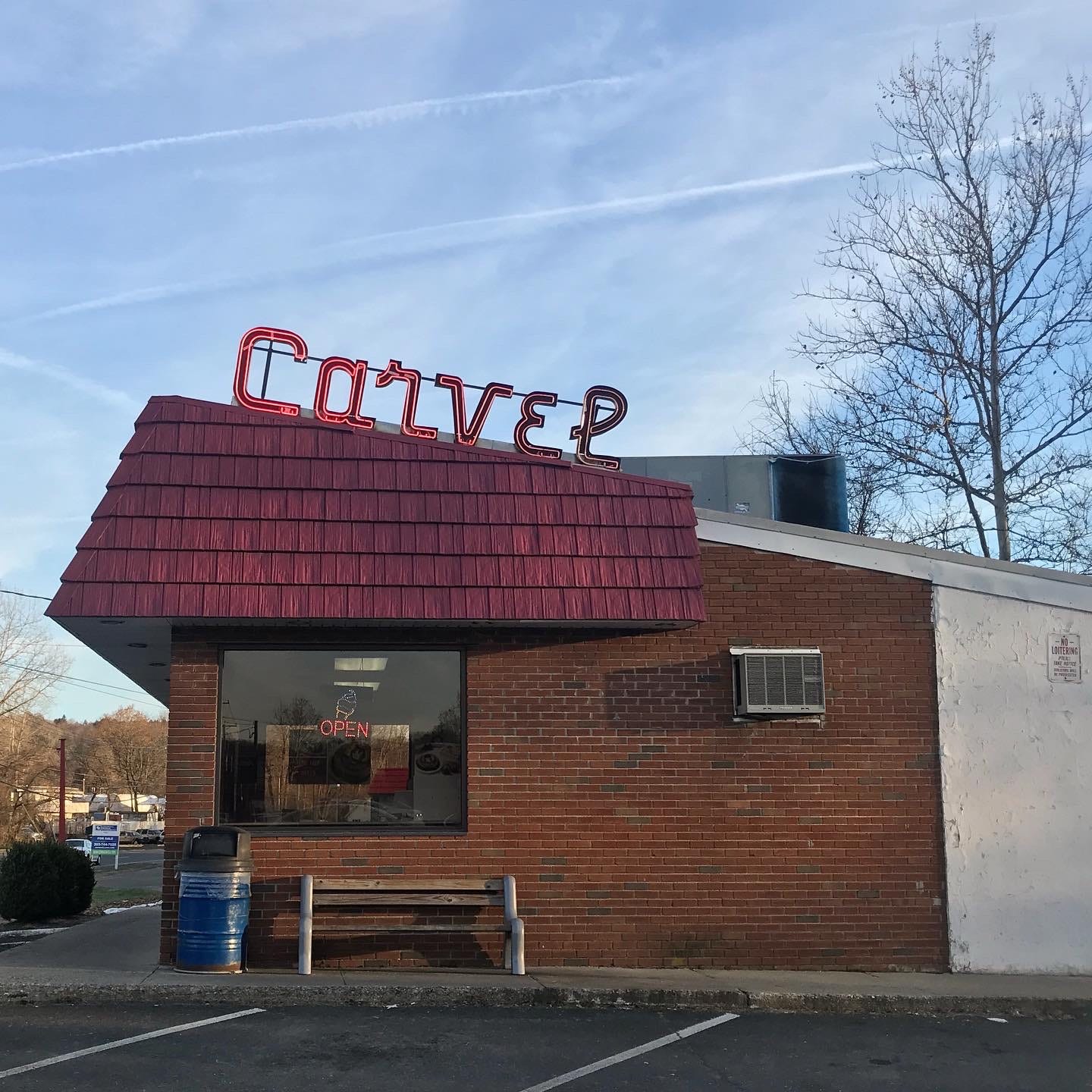
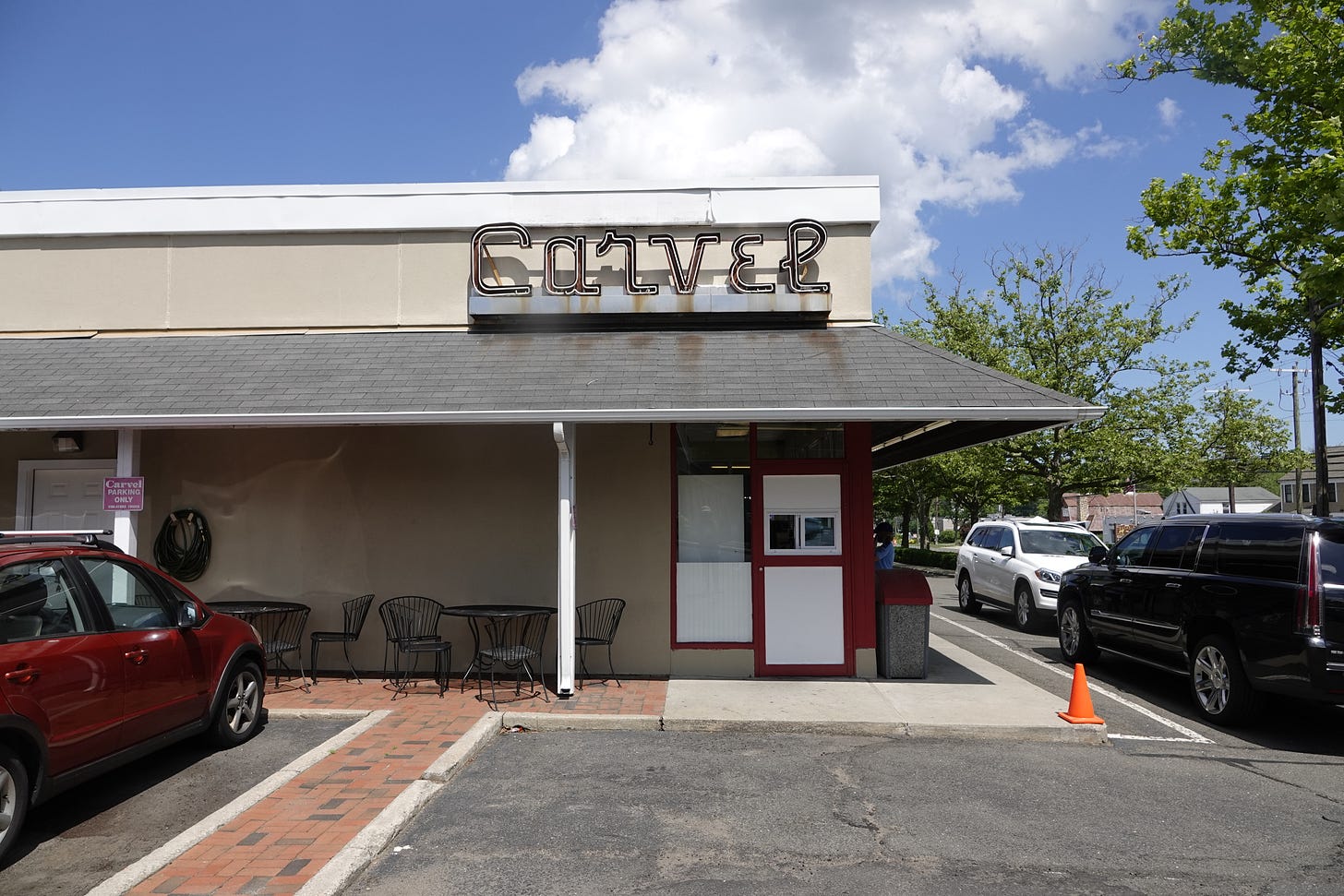

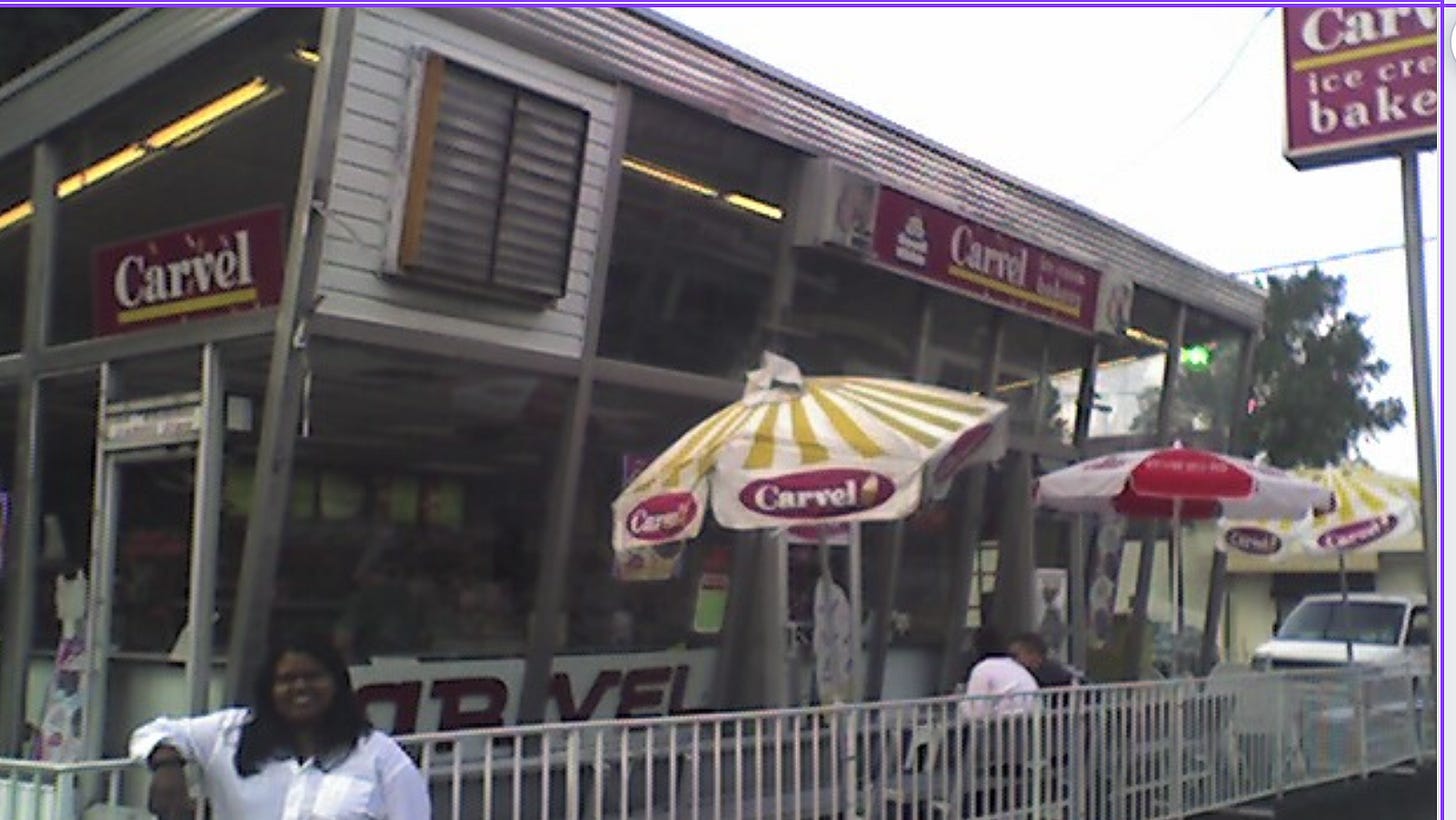
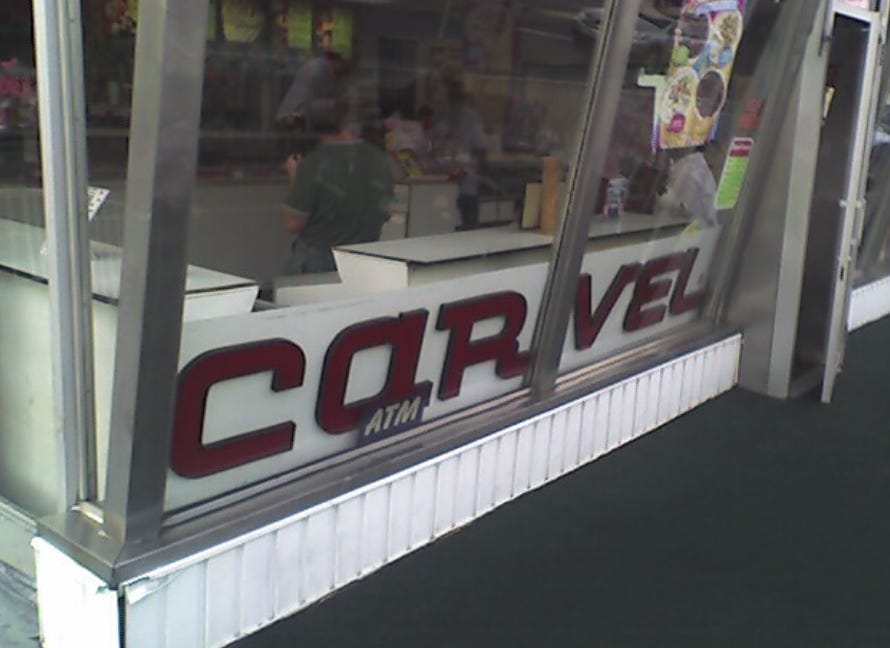

What a treat! Hubie Hamburger AND a photo of the Hackensack Carvel, which was the one my family visited most often.